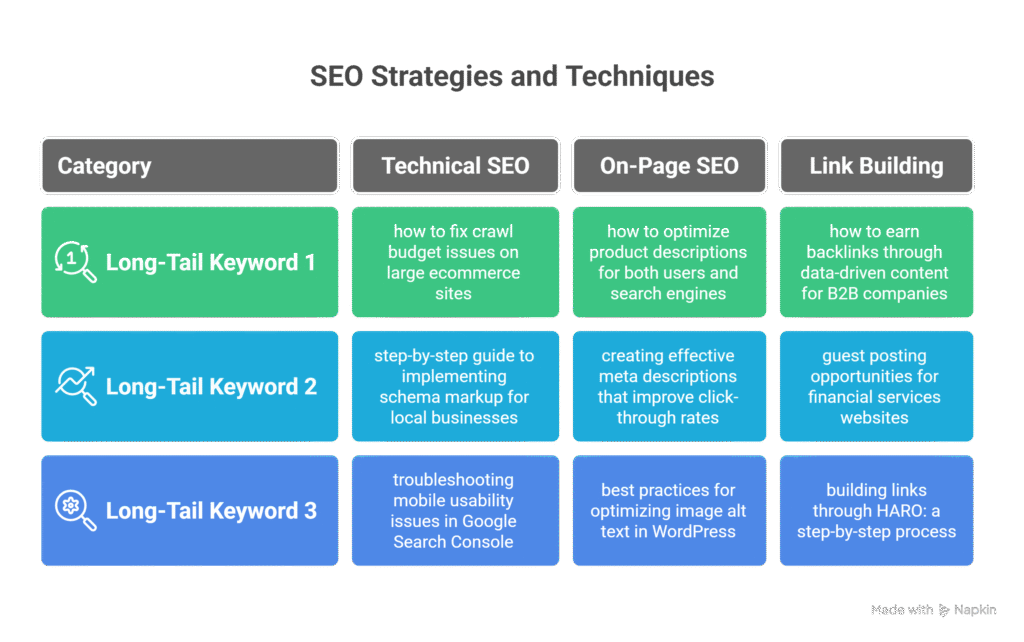Introduction
The Challenge of Standing Out in Crowded Digital Spaces
In today’s digital world, where millions of blogs and websites are competing for attention, ranking high for competitive keywords is an ongoing challenge. But how can you ensure your content not only ranks but also establishes your brand as an authority in your niche?
Pain Point: Struggling to Rank for Competitive Keywords
Despite creating high-quality content, you may find it tough to rank for competitive keywords. This happens because search engines are now focusing on topic relevance rather than just individual keywords.
The Solution: The Pillar-Cluster Model
The pillar-cluster model is the key to building topical authority. This content strategy helps organize your content into a cohesive, interconnected structure that signals expertise to both search engines and users.
What You’ll Learn in This Guide:
- What topical authority is and why it matters for SEO.
- How the pillar-cluster model works.
- A step-by-step guide to implement this strategy.
- Tools and techniques to measure success and track progress.
Quick Win Promise
By the end of this guide, you’ll have actionable steps you can start implementing immediately to build topical authority and improve your rankings.
Understanding Topical Authority
What is Topical Authority?
Topical authority refers to when search engines recognize your website as a trusted source of information on a specific subject. It’s about dominating a broad topic and covering all related subtopics, not just ranking for individual keywords.
Why It Matters for SEO in 2025
- Google’s Shift Towards Topic-Based Evaluation: Search engines are now focusing more on the relevance of topics, rather than individual keywords.
- Improved User Engagement: Users engage more with comprehensive, well-organized content, which leads to better rankings.
Topical Authority vs. Domain Authority
- Domain Authority (DA): A site-wide metric measuring the overall strength of a website’s backlink profile.
- Topical Authority: This focuses on expertise within a specific niche. You can have strong topical authority without high domain authority by focusing on in-depth coverage of specific topics.
Real Examples of Websites with Strong Topical Authority
- HubSpot: Dominates the marketing automation space with its extensive content on marketing, sales, and customer service.
- Healthline: A go-to resource for health and wellness topics, covering a wide range of medical topics with depth.
The Pillar-Cluster Model Explained
Definition and Core Concepts
The pillar-cluster model organizes your content into two main categories:
- Pillar Content: A comprehensive guide on a broad topic.
- Cluster Content: Detailed articles diving into subtopics related to the pillar content.
The pillar page acts as the hub, while cluster pages are the spokes, all interconnected through internal linking.
Pillar Content Characteristics
- Comprehensive Coverage: The pillar page should cover all aspects of the broad topic.
- Long-Form Content: Aim for 3,000+ words for in-depth coverage.
- Broad Topic Focus: For example, a pillar page on “Digital Marketing” would touch on SEO, PPC, and social media.
Cluster Content Elements
- Supporting Subtopics: Cluster pages focus on specific areas, such as “SEO,” “PPC,” and “Email Marketing.”
- Internal Linking: Cluster content should link back to the pillar page and related clusters, creating a web of content.
Planning Your Pillar-Cluster Strategy
Topic Research and Selection
- Market Analysis: Identify trending topics in your niche.
- Keyword Research: You can use tools like Ahrefs or SEMrush to find high-volume, low-competition keywords.
- Competition Assessment: Analyze what your competitors are doing and where they are succeeding.
- Content Gap Analysis: Identify content gaps that your competitors haven’t covered.
Topic Cluster Mapping
- Create a mind map of your pillar topic and subtopics.
Example:- Pillar: “Digital Marketing”
- Clusters: “SEO,” “PPC,” “Social Media Marketing,” “Email Marketing”
Content Calendar Planning
- Schedule content creation and publication dates.
- Allocate resources such as writers, designers, and SEO experts.
Creating Effective Pillar Content
Pillar Page Structure
- Introduction: Define the topic and its importance.
- Sections: Break down the broad topic into key areas.
- Internal Links: Link to relevant cluster content.
- Conclusion: Summarize key points and include a call-to-action (CTA).
SEO Optimization Techniques
- Keyword Usage: Ensure you use primary keywords in headings and meta descriptions.
- Readability: Break text into short paragraphs and use bullet points.
- Multimedia: Include images, videos, and infographics to enhance the user experience.
Examples of Successful Pillar Pages
- Backlinko’s SEO Guide: A comprehensive resource for SEO best practices.
- Moz’s Beginner’s Guide to SEO: Another excellent example of a well-structured pillar page.
Developing Supporting Cluster Content
Identifying Subtopics
- Use keyword research tools to find long-tail keywords related to your pillar topic. Example: For “SEO,” subtopics could include “On-Page SEO,” “Technical SEO,” and “Local SEO.”
Internal Linking Strategies
- Link each cluster page to the pillar page and other related clusters using descriptive anchor text. Example: “Learn more about on-page SEO techniques.”
Content Depth Requirements
- Aim for 1,500+ words per cluster page to provide detailed, actionable insights.
Building Topical Authority with Long-tail Content Clusters: A Comprehensive Guide
The Strategic Power of Long-tail Content Clusters
While broad pillar content establishes the foundation of your topic expertise, long-tail content clusters are the specialized components that truly solidify your topical authority. These focused content pieces target specific questions and needs your audience has, creating a comprehensive knowledge network around your core topics.
What Makes Long-tail Content Clusters Different?
Long-tail content clusters differ from standard cluster content in several important ways:
| Standard Cluster Content | Long-tail Content Clusters |
| Focuses on primary subtopics | Targets specific, niche questions |
| Often targets competitive keywords | Targets lower-competition long-tail phrases |
| Moderate search volume | Lower search volume but higher conversion intent |
| General coverage of subtopics | Hyper-focused on specific user problems |
Step-by-Step Guide: Creating Long-tail Content Clusters
Step 1: Identify Long-tail Keyword Opportunities
Start by building a comprehensive list of long-tail keywords related to your pillar topic. Here’s how:
- Seed Keyword Analysis: Begin with your main pillar topic and primary cluster subtopics
- Keyword Research Tools: Use tools like:
- Ahrefs’ Keywords Explorer (filter for long-tail variations)
- SEMrush’s Keyword Magic Tool (use the “Questions” filter)
- AnswerThePublic to find question-based long-tail keywords
- Search Intent Mining:
- Analyze Google’s “People Also Ask” sections
- Review “Related Searches” at the bottom of search results
- Examine forum discussions on Reddit, Quora, and industry-specific platforms
- Competitive Gap Analysis:
- Identify long-tail keywords your competitors are missing
- Look for questions in your niche that lack comprehensive answers
Example: For a Digital Marketing pillar page, you might find these long-tail opportunities:
- “how to measure ROI from Instagram Stories ads”
- “best practices for optimizing Google My Business for service businesses”
- “step-by-step email nurture sequence for SaaS free trial users”
Step 2: Organize Your Long-tail Clusters
Once you’ve compiled your long-tail keywords, organize them into thematic groups:
- Create Logical Groupings: Cluster similar long-tail keywords together based on:
- Search intent (informational, commercial, transactional)
- Topic relationship
- Target audience segment
- Map to Your Existing Structure: Connect each long-tail cluster to:
- The appropriate pillar page
- The most relevant standard cluster content
- Prioritize Based on Value: Rank your clusters by:
- Search volume potential
- Competition level
- Conversion likelihood
- Content creation difficulty
Visual Framework Example:

Step 3: Create In-depth Long-tail Content
Each long-tail content piece should follow these principles:
- Laser-Focused Topic Coverage:
- Address a single specific question or problem
- Provide the most comprehensive answer available
- Include expert insights not found elsewhere
- Optimal Content Structure:
- Clear, descriptive headline using the long-tail keyword
- Concise introduction stating the problem and solution
- Logical subheadings breaking down the topic
- Practical examples, case studies, or data points
- Visual elements (diagrams, charts, screenshots)
- Actionable conclusion with next steps
- Content Length Considerations:
- Aim for 1,200-2,000 words for most long-tail topics
- Focus on thoroughness rather than arbitrary length
- Include only relevant information (avoid filler)
Real Example Structure for a Long-tail Article:
TITLE: How to Fix Crawl Budget Issues on Large Ecommerce Sites
INTRODUCTION:
- Define crawl budget and why it matters specifically for ecommerce
- Brief overview of the symptoms of crawl budget problems
- What the reader will learn in this guide
SECTION 1: Diagnosing Crawl Budget Issues
- How to use Google Search Console to identify crawl stats
- Key metrics that indicate crawl budget problems
- Common patterns in large ecommerce sites
SECTION 2: Technical Fixes to Implement
- Optimizing robots.txt directives (with code examples)
- Managing faceted navigation and filtering options
- XML sitemap optimization techniques
- Canonical tag implementation strategies
SECTION 3: Content Architecture Solutions
- URL structure best practices
- Category page optimization
- Handling product variations efficiently
- Addressing pagination issues
SECTION 4: Monitoring and Maintenance
- Setting up crawl monitoring tools
- Creating a regular audit schedule
- Key metrics to track over time
CONCLUSION:
- Summary of key action items
- Expected timeframe for improvements
- Next steps for ongoing optimization
INTERNAL LINKS:
- Link to pillar page on SEO
- Link to cluster page on Technical SEO
- Links to related long-tail content like “implementing schema markup”
Step 4: Implement Strategic Internal Linking
The power of long-tail content clusters comes from their interconnectedness:
- Create a Multi-tier Linking Structure:
- Every long-tail piece links to its parent cluster content
- Every long-tail piece links to the main pillar page
- Long-tail content pieces link to related long-tail content
- Use descriptive anchor text containing target keywords
- Update Existing Content:
- Add links from your pillar page to new long-tail content
- Update standard cluster content to reference long-tail pieces
- Create contextual links where topics naturally connect
- Use Link Visualization Tools:
- Map your internal linking structure visually
- Identify opportunities for additional connections
- Ensure no content becomes orphaned
Practical Example of Internal Linking:
For the long-tail article “how to fix crawl budget issues on large ecommerce sites”:
- Link from the pillar page section on Technical SEO using anchor text like “fixing crawl budget issues for large sites”
- Link from the standard cluster page on Technical SEO using anchor text like “optimizing crawl budget for ecommerce websites”
- Link to related long-tail content like “implementing XML sitemaps for large websites” where contextually relevant
- Link to the main pillar page using anchor text like “comprehensive SEO strategy”
Step 5: Measure and Optimize Performance
Track specific metrics to evaluate your long-tail content cluster strategy:
- Keyword-Specific Metrics:
- Ranking positions for target long-tail keywords
- Search visibility for semantic variations
- Featured snippet acquisition
- Traffic and Engagement Metrics:
- Organic sessions to long-tail content
- Time on page compared to site average
- Scroll depth on long-tail articles
- Internal link click-through rates
- Conversion Metrics:
- Entry point analysis (which long-tail content brings in new users)
- Conversion path analysis (how long-tail content contributes to conversions)
- Assisted conversion value
- Authority Signals:
- Backlinks earned to long-tail content
- Social shares and engagement
- Return visitor rate to long-tail content
Performance Optimization Tactics:
- Regularly update high-performing long-tail content with new information
- Expand successful long-tail clusters with additional related keywords
- Repurpose underperforming content to target different long-tail variations
- Strengthen internal linking to boost low-traffic long-tail pages
Case Study: Building Long-tail Authority in Action
Note: Add a relevant case study here. If you don’t have a specific one, I’ve created this hypothetical example:
How Outdoor Gear Review Site Built Topical Authority Through Long-tail Content
Background: A medium-sized outdoor gear review website was struggling to compete with major publications for broad terms like “hiking boots” and “camping tents.”
Strategy Implemented: Rather than competing head-on for competitive terms, they built a comprehensive long-tail cluster strategy around hiking footwear:
- Pillar Page: “Complete Guide to Hiking Footwear”
- Standard Clusters:
- Trail Running Shoes
- Hiking Boots
- Approach Shoes
- Hiking Sandals
- Long-tail Clusters (examples):
- “best waterproof hiking boots for wide feet”
- “how to break in leather hiking boots without blisters”
- “trail running shoes for technical alpine terrain”
- “lightweight hiking sandals for desert backpacking”
Implementation Details:
- Created 35+ long-tail articles over 6 months
- Established a consistent internal linking structure
- Updated content quarterly with new product information
- Added expert commentary from professional hikers and podiatrists
Results After 12 Months:
- Increased organic traffic by 187% year-over-year
- Achieved first-page rankings for 78% of target long-tail keywords
- Improved conversion rate by 23% for affiliate product links
- Established the site as the go-to resource for hiking footwear advice
- Eventually began ranking for more competitive terms like “best hiking boots”
Tools to Support Your Long-tail Cluster Strategy
To effectively implement long-tail content clusters, leverage these tools:
- Keyword Research:
- Ahrefs
- SEMrush
- Clearscope
- MarketMuse
- Content Organization:
- ContentKing
- Notion databases
- Airtable
- Trello/Asana for content planning
- Internal Linking Analysis:
- Screaming Frog SEO Spider
- Sitebulb
- Internal Link Juicer (WordPress plugin)
- Link Whisper (WordPress plugin)
- Performance Tracking:
- Google Search Console
- Google Analytics
- SEO monitoring tools (Moz, Ahrefs, SEMrush)
- HotJar for user behavior analysis
Common Challenges and Solutions
ChallengeSolutionToo many long-tail variations to coverPrioritize based on search volume, competition, and conversion potentialDifficulty finding qualified writers for specialized topicsConsider expert interviews, collaborate with industry professionals, or develop in-house expertiseManaging a large volume of contentImplement a content management system with clear taxonomies and taggingLow traffic to individual long-tail pagesFocus on the collective impact of the cluster, not individual page metricsMaintaining content freshnessCreate a regular audit schedule and update cycle for all long-tail content
Quick Start: Your 30-Day Long-tail Cluster Implementation Plan
Ready to get started? Follow this 30-day implementation plan:
Days 1-5: Research & Planning
- Identify one pillar topic to focus on first
- Research 20-30 long-tail keyword opportunities
- Group them into 5-7 logical clusters
- Prioritize the top 3 long-tail articles to create first
Days 6-15: Content Creation
- Develop detailed outlines for your first 3 long-tail articles
- Create comprehensive content addressing each long-tail topic
- Include visual elements and expert insights
- Optimize on-page elements for target keywords
Days 16-20: Publishing & Linking
- Publish your first long-tail articles
- Implement strategic internal linking
- Update existing content to link to new long-tail pieces
- Set up tracking in Google Analytics and Search Console
Days 21-30: Analysis & Expansion
- Monitor initial performance metrics
- Begin research for the next batch of long-tail content
- Make adjustments based on early data
- Plan your content calendar for months 2-3
By following this structured approach to creating long-tail content clusters, you’ll build topical authority more effectively than competitors who focus solely on competitive keywords. Over time, this strategy will help you dominate your niche and drive more targeted traffic to your website.
Implementation Steps
Technical Setup Requirements
- Ensure your Content Management System (CMS) supports internal linking and SEO optimization.
- Use plugins like Yoast SEO or Rank Math for SEO settings.
Content Creation Workflow
- Write the pillar page first.
- Develop cluster content based on the pillar structure.
- Add internal links to the cluster pages as you write.
Performance Tracking Setup
- Use Google Analytics and Google Search Console to track organic traffic, keyword rankings, and user engagement.
Measuring Success
Key Performance Indicators (KPIs)
- Organic Traffic Growth: Are users visiting your site more often?
- Keyword Rankings: Are you ranking higher for your target keywords?
- User Engagement: Are users spending more time on your site?
- Conversion Rates: Are users taking actions like signing up or making a purchase?
Tools and Software for Tracking
- Ahrefs: For keyword tracking and backlink analysis.
- Google Data Studio: To create custom reports based on performance metrics.
Common Challenges and Solutions
Resource Constraints
Solution: Start small with one pillar and a few clusters, then scale over time.
Content Organization Issues
Solution: Use tools like Trello or Notion to map out your content and keep it organized.
Technical Implementation Problems
Solution: Work with a developer to ensure proper internal linking and URL structure.
Advanced Strategies
Multi-Pillar Integration
- Create multiple pillar pages for different topics and cross-link between them when relevant.
Content Updating Strategies
- Regularly update both pillar and cluster pages with new information to keep them relevant.
How To Long Tail Content Clusters To Build Topical Authority
Understanding Long-tail Keywords in Content Clusters
Long-tail keywords are specific, often longer search phrases that typically have lower search volume but higher conversion potential. When building content clusters, these keywords are your secret weapon for establishing topical authority. Here’s why they matter:
The Power of Long-tail Keywords in Cluster Content
- They represent specific user intent, making it easier to create targeted content
- Face less competition compared to broad keywords
- Often have higher conversion rates due to their specificity
- Help you capture diverse segments of your target audience
How to Identify Long-tail Keywords for Your Clusters
- Start with your main pillar topic
- Use keyword research tools to find related long-tail variations
- Analyze search intent behind these keywords
- Group similar long-tail keywords into potential cluster topics
Advanced Cluster Content Development for Long-tail Keywords
Creating Topic Clusters Around Long-tail Keywords
Start by organizing your long-tail keywords into thematic groups. For example, if your pillar page is about “Digital Marketing,” your long-tail clusters might include:
- “how to create social media marketing strategy for small business”
- “best email marketing automation tools for ecommerce”
- “local SEO optimization techniques for restaurants”
Structuring Your Long-tail Content
Each cluster article should:
- Focus on a specific long-tail keyword group
- Provide in-depth information about the subtopic
- Link back to the pillar page using relevant anchor text
- Connect with other related cluster content
- Include semantic variations of the target long-tail keyword
Optimizing Cluster Content for Search Intent
- Informational Intent
- Create how-to guides
- Develop step-by-step tutorials
- Write comprehensive explanations
- Commercial Intent
- Product comparison articles
- Buying guides
- Best-of lists
- Transactional Intent
- Product features and benefits
- Service descriptions
- Pricing comparisons
Implementation Strategy for Long-tail Content Clusters
Step 1: Research and Planning
- Use tools like Google’s People Also Ask
- Analyze competitor content gaps
- Review your existing content for potential cluster opportunities
- Map out content relationships
Step 2: Content Creation
- Write comprehensive cluster articles (1,500+ words)
- Include relevant statistics and data
- Add visual content to enhance engagement
- Optimize meta descriptions and titles for long-tail keywords
Step 3: Internal Linking Structure
- Create a hub-and-spoke linking pattern
- Use descriptive anchor text
- Ensure all cluster content links back to the pillar page
- Cross-link between relevant cluster articles
Measuring Success with Long-tail Content Clusters
Key Metrics to Track
- Organic Traffic Growth
- Track individual cluster page performance
- Monitor long-tail keyword rankings
- Analyze user engagement metrics
- Conversion Metrics
- Time on page for cluster content
- Bounce rate comparison
- Goal completion rates
- Click-through rates from cluster to pillar content
Optimization Tips
- Regularly update cluster content with new information
- Add new long-tail variations as they emerge
- Monitor search trends for content opportunities
- Adjust internal linking based on performance data
Technical Considerations for Long-tail Content Clusters
URL Structure Best Practices
- Use clear, keyword-rich URLs
- Maintain a logical hierarchy
- Keep URLs relatively short
- Include target long-tail keywords when relevant
On-Page Optimization
- Optimize title tags with long-tail keywords
- Create unique meta descriptions
- Use proper heading hierarchy (H1-H6)
- Include semantic variations in subheadings
Mobile Optimization
- Ensure responsive design
- Optimize page load speed
- Use mobile-friendly formatting
- Consider mobile user intent in content structure
Case Studies
Real-World Examples
- HubSpot’s Marketing Hub: A masterclass in topical authority, with detailed guides on marketing, sales, and customer service.
- Healthline’s Health Topics: Dominates the health and wellness niche by publishing comprehensive, high-quality content on medical topics.
Conclusion
Summary of Key Points
- Topical authority is critical for SEO success in 2025.
- The pillar-cluster model helps you organize content effectively, building authority and improving rankings.
- Start small, track performance, and scale over time.
Ready to Dominate Your Niche with Topical Authority? Let Peakontech Guide You!
At Peakontech, we specialize in helping brands like yours build topical authority and climb the search engine rankings with proven strategies like the Pillar-Cluster Model. Whether you’re just starting out or looking to refine your existing content strategy, our team of SEO experts is here to help.
Here’s how we can help you succeed:
- Custom Content Strategy: We’ll create a tailored plan to build your topical authority, from pillar pages to cluster content.
- SEO Optimization: Our team will ensure your content is optimized for search engines and user engagement.
- Performance Tracking: We’ll monitor your progress and make data-driven adjustments to keep you ahead of the competition.
Take the First Step Toward SEO Success!
📞 Book a Free Consultation: Let’s discuss how we can help you achieve your SEO goals.
Don’t let your competitors outrank you. Build your topical authority with Peakontech today!
FAQ Section
How long does it take to see results?
- Typically, 3-6 months of consistent effort.
Do I need a large team to implement this?
- No, you can start with a small team and scale as needed.

PEAKONTECH is a data-driven digital marketing agency offering full-stack services including SEO, paid ads, web design, CRO, and e-commerce development. From Shopify to WordPress, and from social media to automation — our team helps brands grow smarter and scale faster across every digital touchpoint.



